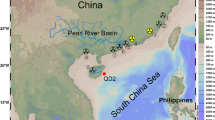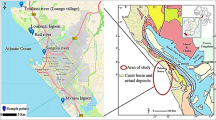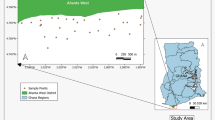Abstract
Radionuclides within the environment are not always a point of concern, in some cases they can be used to trace and identify incidents even long after they occurred. This reports performs a high resolution spectrometry analyses for several samples taken from the Black Sea containing seawater and sediments. The results give us the opportunity to use traceable radionuclides like 137Cs or 40K as tracers for the human activities within the western Black Sea area. Although the presence of such radioisotopes can be related to the Chernobyl event, results can be differentiated using other radioisotopes associated to the same event but having a specific timespan since them as the case for 241Am. Using such tracers one can isolate events from 30 years ago from the more recent ones.
Access provided by CONRICYT-eBooks. Download chapter PDF
Similar content being viewed by others
Keywords
- Marine radioactive
- Black Sea
- Seawater
- Sediment samples
- Gamma spectrometry
- Radionuclide
- Spectrometer calibration coefficient correction
1 Introduction
The Black Sea shelf region is important to our regional ecosystem due the fact that here many of the waters coming from all surrounding countries contribute the composition. A special place in this topic is the Danube as a European River it comes from as far as Germany and can collect in its path many effluents from several installations. This report presents our efforts to perform radionuclide evaluation for both water and sediment samples. As we can expect, to this inventory can contribute the Cernavoda Nuclear Power Plant but we can also point out the effects for the Chernobyl event that releases a large amount of radionuclides within the atmosphere. While previous studies for the Black Sea sector analyze the whole basin, this work focuses on the Romanian sector 30 years after Chernobyl incident (Bologa and Patrascu 1996).
Within this report we employed only high resolution gamma spectrometry for our samples and the report is following the natural radionuclide series and 137Cs as a marker for human activity.
Samples were taken from the locations presented in Fig. 13.1 under the approximate same timing and conditions ensuring that their population is consistent with each other.
Also, a radionuclide occurring mainly through nuclear activities, the 241Am shows a great potential for being used as a tracer for a better assessment of the Chernobyl nuclear incident.
2 Material and Methods
Water and sediment samples were collected on-board R/V “Steaua de Mare I” (National Institute for Marine Research and Development „Grigore Antipa” – NIMRD) during 30 March–04 April 2016 on standard monitoring oceanographic stations. Seawater at 2 m above the maximum depth of each station was collected using bathometers and Van Veen grab for sediments samples. The sea currents were measured using the ADCP (Acoustic Doppler Current Profiler) during winter 2010 (February) by the NIMRD. The primary production concentration images and data are retrieved on-line from the dvs.net.ru (Remote Sensing Department Federal State Budget Scientific Institution “Marine Hydrophysical Institute of RAS”) for the period of the in-situ water and samples data (images are cropped for the analyzed period).
The method used for sediments samples was adapted on-board taking into consideration the weather and sampling conditions. The sediments samples were collected from the middle of the samples grab using a specialized palette (Figs. 13.2 and 13.3).
All samples are taken from the shoreline (considered 0 m water depth) to off-shore waters (maximum depth of 100 m) and are subject to shoreline specific models, meaning that after this distance all graphs and interpolations suffer from a dilution in consistency.
In order to avoid sample contamination, each sample was taken using only clean materials and sample cases and ensure that the samples are not touched or any way tampered with for the time in the open. For this, soil and water samples were taken out from the water were isolated in a timespan under 10 s from the moment they are exposed to the air.
The sediment samples, dried at constant mass of about 150 g, were placed in cylindrical hermetically closed boxes. The water samples, about 500 g, were placed in 130 g hermetically closed Marinelli beakers. The samples were stored for 28 days for radioactive equilibrium.
The activity concentrations of 232Th, 226Ra, 137Cs and the 40K radionuclides were determined using a CANBERRA system consisting of a n-type, 0.6 mm epoxy carbon HPGe detector with ISOXCALL characterization, a DSA 1000 multichannel analyzer and 747 type lead shield. The detector has a relative efficiency of 40% and the resolution is 1.96 keV at 60Co 1332 keV and 0.89 keV at 57Co 122 keV line. GENIE 2000 software was used for data acquisition and processing while the efficiency calibration, self-absorption and coincidence summing correction were performed by using a CANBERRA LabSOCS software. The background contribution was obtained as the average of three independent measurements, each of them of 200,000 s. The nuclear data were those provided by Chu et al. (1999) while the spectral lines overlapping were corrected by the method presented in (Tugulan and Duliu 2014).
The 232Th natural series was investigated by means of gamma spectra of descending radionuclides 228Ac (209.25 keV, 794.95 keV, 911.20 keV and 968.97 keV), 212Pb (238.63 keV), 212Bi (with energy 727.33 keV and 1620.50 keV) and 208Tl (583.19 keV and 860.56 keV). In the case of 226Ra series, was used the gamma spectra of 214Pb (295.22 keV and 351.93 keV) and 214B (609.31 keV, 768.36 keV, 934.06 keV, 1120.29 keV, 1661.28 keV, 1729.60 keV and 1847.42 keV). 40K has single gamma emission energy of 1460.83 keV.
For the spectrometric system, the accuracy of radiometric measurements was checked by using the IAEA certified materials IAEA-RGTh-1 (Thorium Ore), IAEA-384 (Fangataufa Sediment) and IAEA-385 (Irish Sea sediment). Differences between the measured and certified values were less than 5%.
3 Results
Each sample was evaluated for its radionuclide concentrations and in some cases, like the off-shore water samples from Constanta Est 6 and 7, the measurements were under the minimum detectable activity (MDA) and no radionuclide was clearly identified above the background radiation. Water samples provide specific issues regarded to the gamma scattering and attenuations within the sample and the actual efficiency and calibration correction coefficients needed to be adjusted for the actual experimental setup using LabSOCS detector simulation. While other codes like GESPECOR (Sima and Arnold 2002) provide a consistent overview, we employed LabSOCS as the spectrometer supplier main method for parameter correction (Done et al. 2015) (Table 13.1).
Soil samples, mainly sediments, raised specific issues related to the homogeneity due the fact that each area has specific soil compositions. In order to provide accurate results, each sample has to be corrected to its specific density, weight and size – meaning for each sample, different detector coefficient corrections needed to be applied. The presence of wood and other materials was avoided due the fact that they have high concentrations of 40K (Table 13.2).
Sediment samples are more consistent on radionuclides and their concentration can be estimated to an average uncertainty of 20%. As geometries are similar, trends and distributions can be calculated from this information.
This is not the case for seawater samples where only a few of the radionuclides can be evaluated with a consistent uncertainty and no distribution or trend analysis can be performed for the overall set.
4 Discussion
The sediment distributions on the western Black Sea shelf follow the sea currents feature in the area. At the Danube mouths there are two main streams: one from north to south and the other from south to north. From north to south current flows near shallow waters (near-shore) on the entire depth with speeds range from 0.33 to 0.47 m/s. The river currents spread fan-shaped with rapid decrease in their speed. After mixing with the Black Sea waters, the river currents are influenced by the coastal currents and the river discharge.
In cold season, winter, the sea currents are stable due to the wind intensity and stability. Current flows from south to north in a compact mass, down to 10 m water depth and a width of 40 nautical miles and tends to push but to maintain the north-south current near the coast. The current from south to north has a maximum speed of 0.47 m/s (Fig. 13.4).
Sediment sample distribution has an expected shape, the shoreline is more consistent for earth like radionuclides like 226Ra and 232Th as the waters a shallow and the radionuclide behavior is similar the one found in ground sites. Their concentration decreases with the distance to the shoreline (Fig. 13.5).
These plots can be referenced as natural radioisotopes specific to the soil it’s composition for the Dobrogea seashore areas while the following radionuclides that we evaluated can be linked to the presence of human activities (in the case for 137Cs) or with natural materials for 40K.
The values are in good concordance with the one previously taken for the Black Sea (Valeva et al. 2002) (Fig. 13.6).
Average 137Cs detected concentrations fall under the UNSCEAR (UNSCEAR 2011) reports average for our country and no unusual concentrations were found within this study. The higher concentrations on the Danube Delta interface to the Back Sea can be due to nuclear activities at Cernavoda but the detected value is well less the exception concertation. Concentrations up to 40 Bq/Kg are common to the Chernobyl event (Blebea-Apostu et al. 2012). Activities for similar studies showing higher Cs concentrations can be found in literature (Mohammad Reza Abdi et al. 2009) (Fig. 13.7).
Potassium 40 is one key radionuclide associated to both animal and vegetal concentrations and its distribution can be correlated to such activities or to large deposits of wood or other construction materials leading to higher concentrations within specific regions along the shore line. The above picture presents the sediment sample distribution for the 40K radionuclide. We have to notice that the specific activity for the 40K radionuclide is half of that reported by other institutions (UNSCEAR 2008). 40K present high values in concentrations in near-shore areas: at the Danube mouths and in highly commercial routes dynamical zones such as the upwelling events that occur mainly in spring followed by algae bloom (Mihailov et al. 2012). The primary production in the western Black Sea shelf, estimated as chlorophyll-a concentration (Fig. 13.8), present high concentration in previously mentioned areas mainly in front of the Danube Mouth due to the nutrient rich waters. Also, in this shallow areas, the sediment transport is very dynamic due to the sea currents and waves. The north-to-south regional depth circulation feature determine at the 20 m isobaths similar values of 200–240 Bq/kg.
Long term radioisotopes like 241Pu with a halflife of 14 years (Boulyga et al. 1997; Sasahara et al. 2004; Rumynin and Nikulenkov 2016) released in large amounts by the Cernobyl event, are responsible, among other processes, for the presence of 241Am that can be traced within our samples.
5 Conclusion
Radioisotope inventory analysis for the black sea area (at least for Romanian Shore line) can be a valuable tool for contamination analysis but specific techniques have to be developed for such activities. The wide variety of samples and sample type and their densities can raise specific issues while using specialized high resolution spectrometry (using GeHP detectors with standard POPTOP coaxial geometry) and require detector calibration coefficient correction for each sample but, at least for sediment samples can provide lower MDA’s and high confidence results.
The case for seawater samples, standard radioisotopes cannot always be determined but in some cases the simple presence of radionuclides like 241Am in the Constanta EST 2 location can be traced to the Chernobyl Event. In this specific case, the higher 241Am is correlated with a high concentration in 137Cs and by its mean we can trace it back to the 241Puradionuclides given by Chernobyl (Muravitsky et al. 2005).
While previous studies focus on air distribution (Nikolaos Evangeliou et al. 2016) for major radionuclides this method applied to sediment samples can use 241Am as a tracer for major nuclear incidents in Europe and the presence of both Black Sea – a semi closed basin – and the Danube (a river running along nearly half of Europe) give an opportunity for an better assessment of the main nuclear incident in Eurasia, the Cernobyl event.
References
Abdi MR, Hassanzadeh S, Kamali M, Hamid Reza Raji (2009) 238U, 232Th, 40K and 137Cs activity concentrations along the southern coast of the Caspian Sea, Iran. Mar Pollut Bull 58(5):658–662, ISSN 0025-326X, doi: 10.1016/j.marpolbul.2009.01.009
Blebea-Apostu AM, Radulescu I, Margineanu R et al (2012) Assessment of sedimentation rate through the use of anthropogenic 137Cs radionuclide. Romanian Reports in Physics 64(1):211–220
Bologa AS, Patrascu V (1996) Radioactivity in the Romanian Black Sea Sector one decade after Cernobyl. One Decade after Cernobyl: Summing up the consequences of the incident, IAEA
Boulyga SF, Erdmann N, Funk H, Kievets MK, Lomonosova EM, Mansel A, Trautmann N, Yaroshevich OI, Zhuk IV (1997) Determination of isotopic composition of plutonium in hot particles of the Cernobyl area. Radiat Measur Int Conf Nucl Tracks Solid 28(1–6):349–352. doi:10.1016/S1350-4487(97)00098-X
Chu SYF, Ekstrm LP, Firestone RB (1999) The Lund/LBNL nuclear data search. http://nucleardata.nuclear.lu.se. Accessed on Jan 2017
Done L, Ţugulan LC et al (2015) Comparison of LabSOCS and GESPECOR codes used in gamma-ray spectrometry. Appl Radiat Isot, 109:539–543, ISSN 0969-8043, doi: 10.1016/j.apradiso.2015.11.036.
Evangeliou N, Hamburger T, Talerko N, Zibtsev S, Bondar Y, Stohl A, Balkanski Y, Mousseau TA, Møller AP (2016) Reconstructing the Chernobyl Nuclear Power Plant (CNPP) accident 30 years after. A unique database of air concentration and deposition measurements over Europe. Environ Pollut, 216:408–418, ISSN 0269-7491, doi: 10.1016/j.envpol.2016.05.030.
Lujanienė G, Remeikaitė-Nikienė N, Garnaga G, Jokšas K, Šilobritienė B, Stankevičius A, Šemčuk S, Kulakauskaitė I (2014) Transport of (137)Cs, (241)Am and Pu isotopes in the Curonian Lagoon and the Baltic Sea. J Environ Radioact 127:40–49. doi:10.1016/j.jenvrad.2013.09.013
Mihailov M-E, Tomescu Chivu M-I, Dima V (2012) Black Sea water dynamics On the Romanian Littoral – case study: the upwelling phenomena. Romanian Rep Phys 64(1):232–245
Muravitsky AV, Razbudey VF, Tokarevsky VV, Vorona PN (2005) Time-dependent 241Am activity in the environment from decay of 241Pu released in the Chernobyl accident. Appl Radiat Isot, 63(4):487-492, ISSN 0969-8043. doi: 10.1016/j.apradiso.2005.03.018
NASA Goddard Space Flight Center (2016) Ocean Ecology Laboratory, Ocean Biology Processing Group. Moderate-resolution Imaging Spectroradiometer (MODIS) Aqua Data; NASA OB.DAAC, Greenbelt, MD, USA. Accessed 3 Apr 2016
Remote Sensing Department (2017) Federal State Budget Scientific Institution “Marine Hydrophysical Institute of RAS”. http://dvs.net.ua, Sevastopol. Accessed Jan 2017
Rumynin VG, Nikulenkov AM (2016) Geological and physicochemical controls of the spatial distribution of partition coefficients for radionuclides (Sr-90, Cs-137, Co-60, Pu-239,240 and Am-241) at a site of nuclear reactors and radioactive waste disposal (St. Petersburg region, Russian Federation). J Environ Radioact 162–163:205–218. doi:10.1016/j.jenvrad.2016.05.030. PMID: 27267158.
Sasahara A, Matsamura T, Nicolaou G, Papaioannou D (2004) Neutron and Gamma Ray Rource Evaluation of LWR High Burn-up UO and MOX Spent fuels. J Nucl Sci Technol 41:448–456
Sima O, Arnold D (2002) Transfer of the efficiency calibration of Germanium gamma-ray detectors using the GESPECOR software. Appl Radiat Isot 56(1–2):71–75, ISSN 0969-8043. doi: 10.1016/S0969-8043(01)00169-5
Ţugulan LC, Duliu OG (2014) Annual dose rate determination by high resolution gamma spectrometry for TL dating of loess deposits in South-Eastern Dobrudjea, Romania. Rom Rep Phys 66:862–876
UNSCEAR (2008) Report to general assembly. Annex B: report to general assembly with scientific annexes. Sources and effects of ionizing radiation. United Nations Sales Publications No. E.10.Xi.3 Volume I. New York
UNSCEAR (2011) Sources and effects of ionizing radiation, United Nations Scientific Committee on the Effects of Atomic Radiation, UNSCEAR 2008 Report to the General Assembly volume II, ISBN 978-92-1-142280-1
Valeva B, Kozly L, Yushchenko S, Maderich V, Mungov G (2002) Assessment of radionuclide contamination in the Black Sea using POSEIDON/RODOS system. Radioprotecion 37. doi:10.1051/radiopro/2002210
Author information
Authors and Affiliations
Corresponding author
Editor information
Editors and Affiliations
Rights and permissions
Copyright information
© 2018 Springer International Publishing AG
About this chapter
Cite this chapter
Chiroşca, G., Mihailov, ME., Ţugulan, C.L., Chiroşca, A.V. (2018). Radionuclides Assessment for the Romanian Black Sea Shelf. In: Finkl, C., Makowski, C. (eds) Diversity in Coastal Marine Sciences. Coastal Research Library, vol 23. Springer, Cham. https://doi.org/10.1007/978-3-319-57577-3_13
Download citation
DOI: https://doi.org/10.1007/978-3-319-57577-3_13
Published:
Publisher Name: Springer, Cham
Print ISBN: 978-3-319-57576-6
Online ISBN: 978-3-319-57577-3
eBook Packages: Earth and Environmental ScienceEarth and Environmental Science (R0)












